Abstract
Sera from 17 of 18 adult volunteers challenged with a virulent serotype 1 rotavirus strain (D) were examined for prechallenge antibody levels against several well-defined rotavirus VP7 and VP4 neutralization epitopes by a competitive epitope-blocking immunoassay (EBA) in order to determine whether correlates of resistance to diarrheal illness could be identified. The presence of prechallenge serum antibody at a titer of greater than or equal to 1:20 that blocked the binding of a serotype 1 VP7-specific monoclonal antibody (designated 2C9) that maps to amino acid residue 94 in antigenic site A on the serotype 1 VP7 was significantly associated with resistance to illness or shedding (P less than 0.001) or illness and shedding (P less than 0.01) following challenge with the serotype 1 virus. In addition, an EBA antibody titer of greater than or equal to 1:20 in prechallenge serum against a serotype 3 VP7-specific epitope (defined by monoclonal antibody 954/159) that maps to amino acid 94 on the serotype 3 VP7 was also significantly associated with resistance to illness or shedding (P = 0.02), with a trend for protection against illness and shedding. A trend was also noted between the presence of EBA antibody against a cross-reactive VP4 epitope common to many human rotavirus strains, including the challenge virus, or a rhesus monkey rotavirus strain-specific VP4 antigenic site, and resistance to illness or shedding. These data confirm that the presence of serum antibody correlates with resistance to rotavirus illness or shedding but, in addition, demonstrate the association of antibody to a specific epitope with resistance to illness or shedding. These data also suggest that antigenic site A on the rotavirus VP7, composed of amino acids 87 to 96, may be involved in the formation of a major protective epitope. Further study of the role of this epitope in the development of homotypic and heterotypic immunity to rotaviruses following natural or vaccine-induced infection may be important in the development of strategies for control of rotavirus diarrheal disease.
Full text
PDF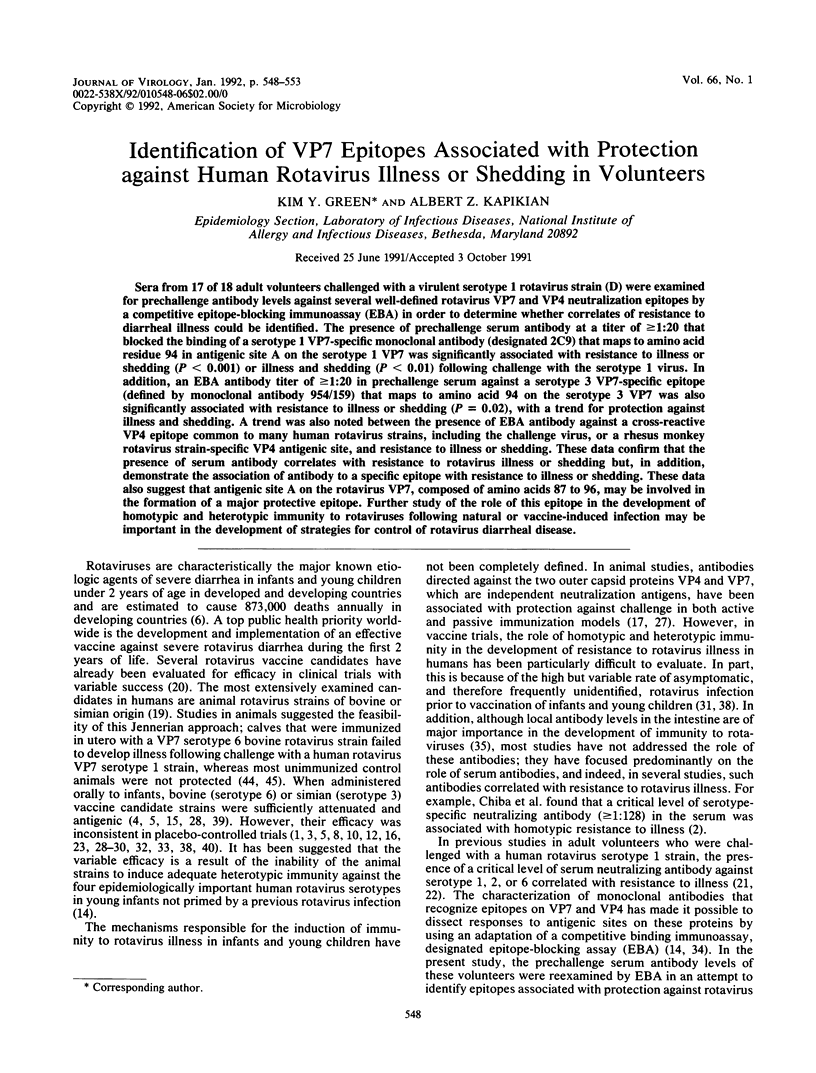
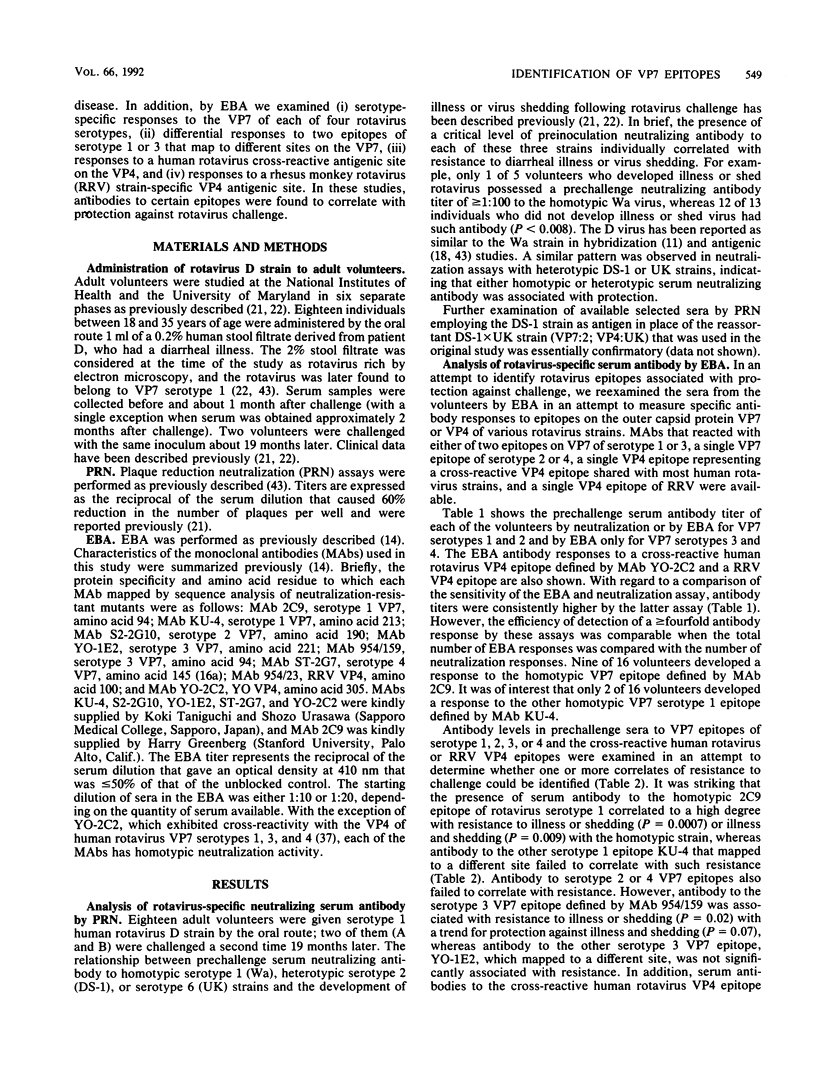
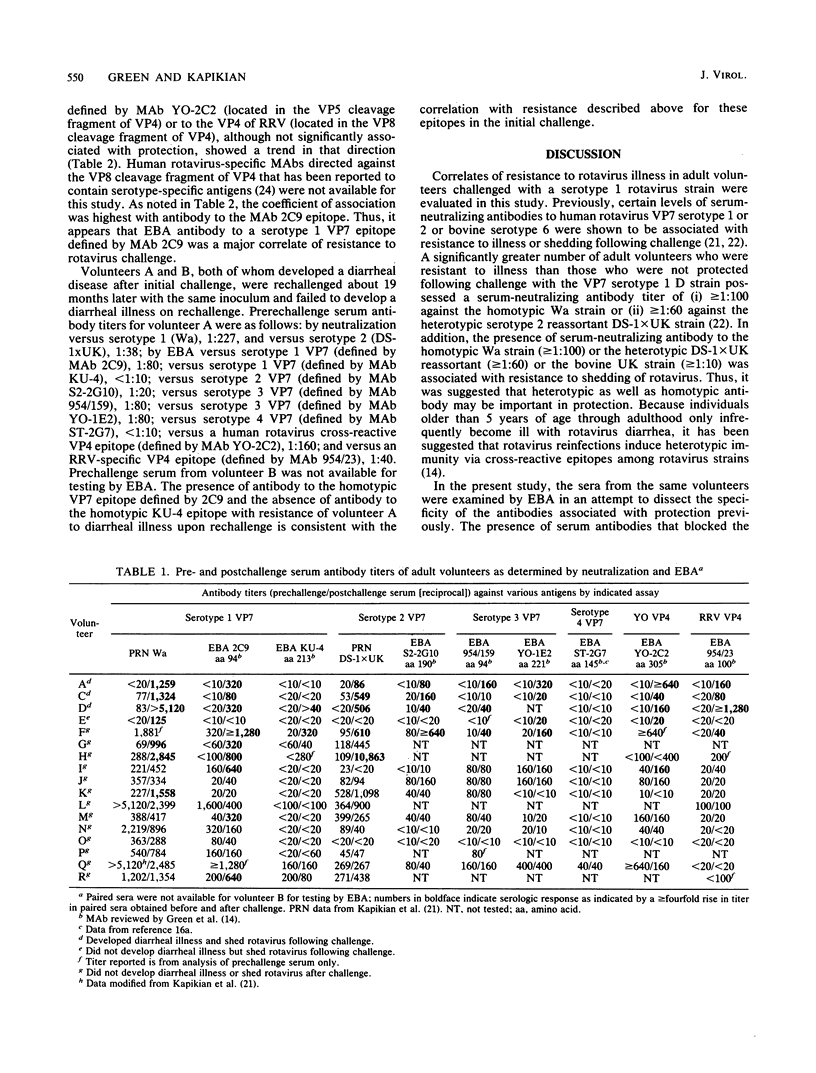
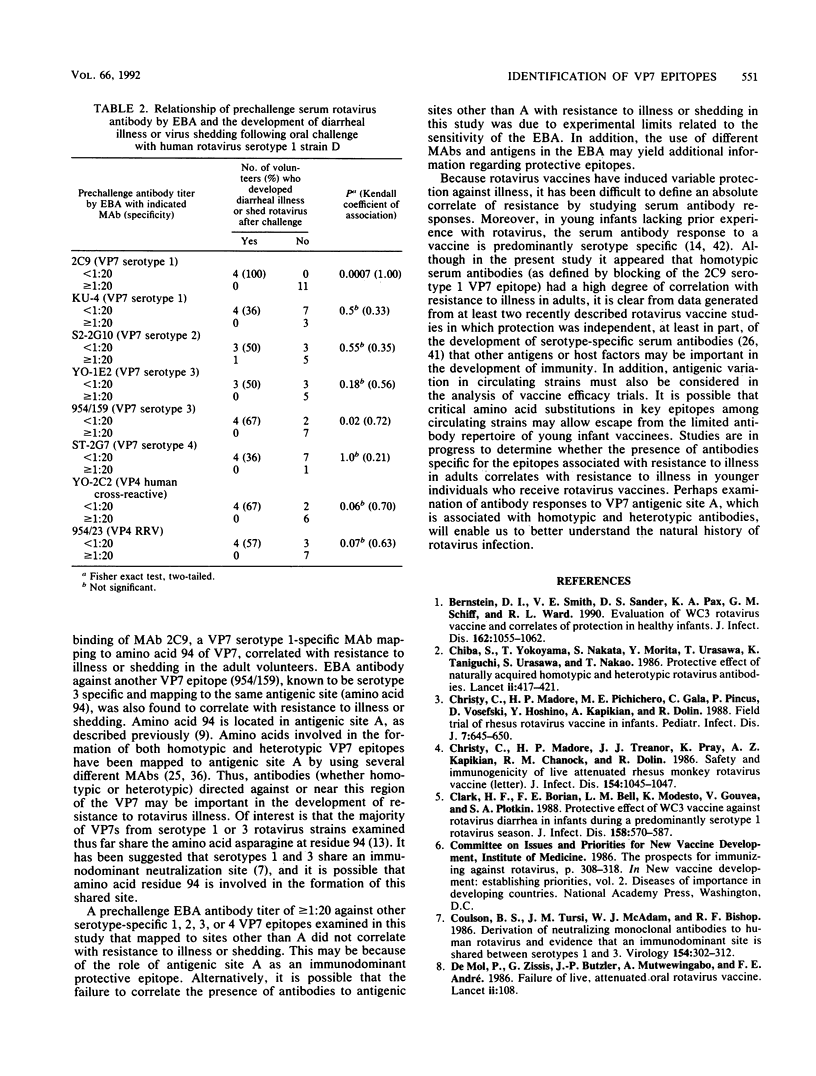
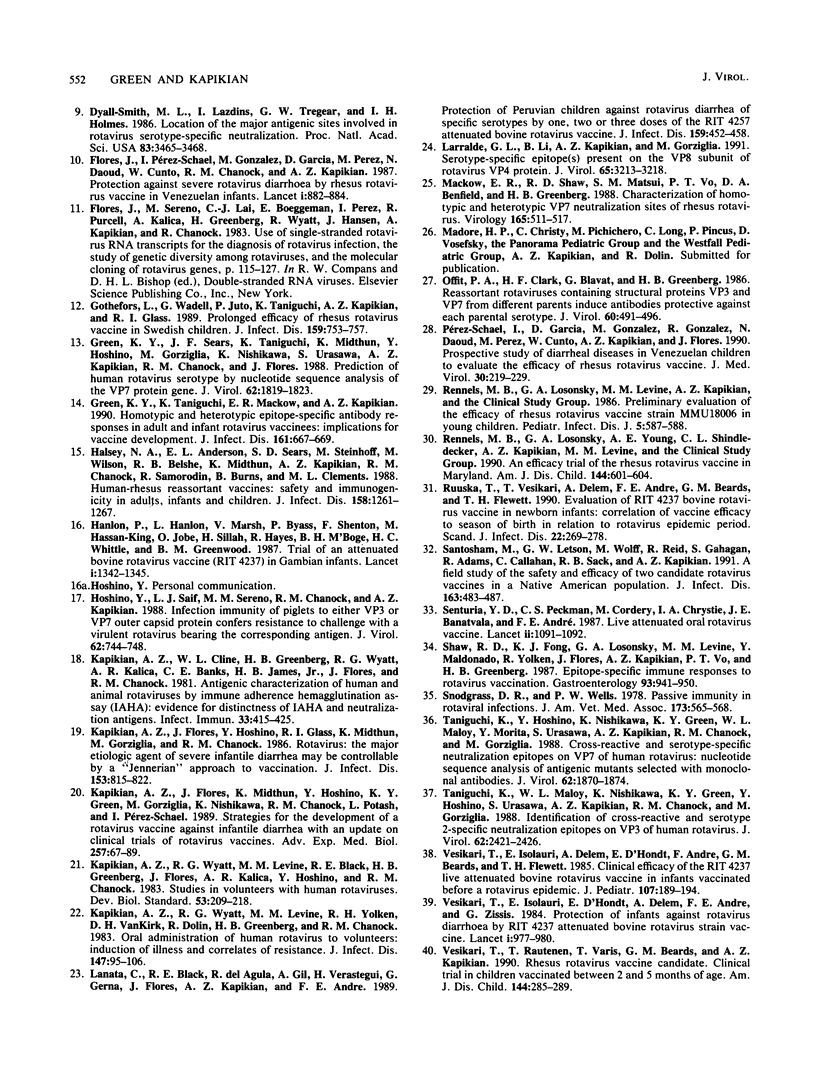
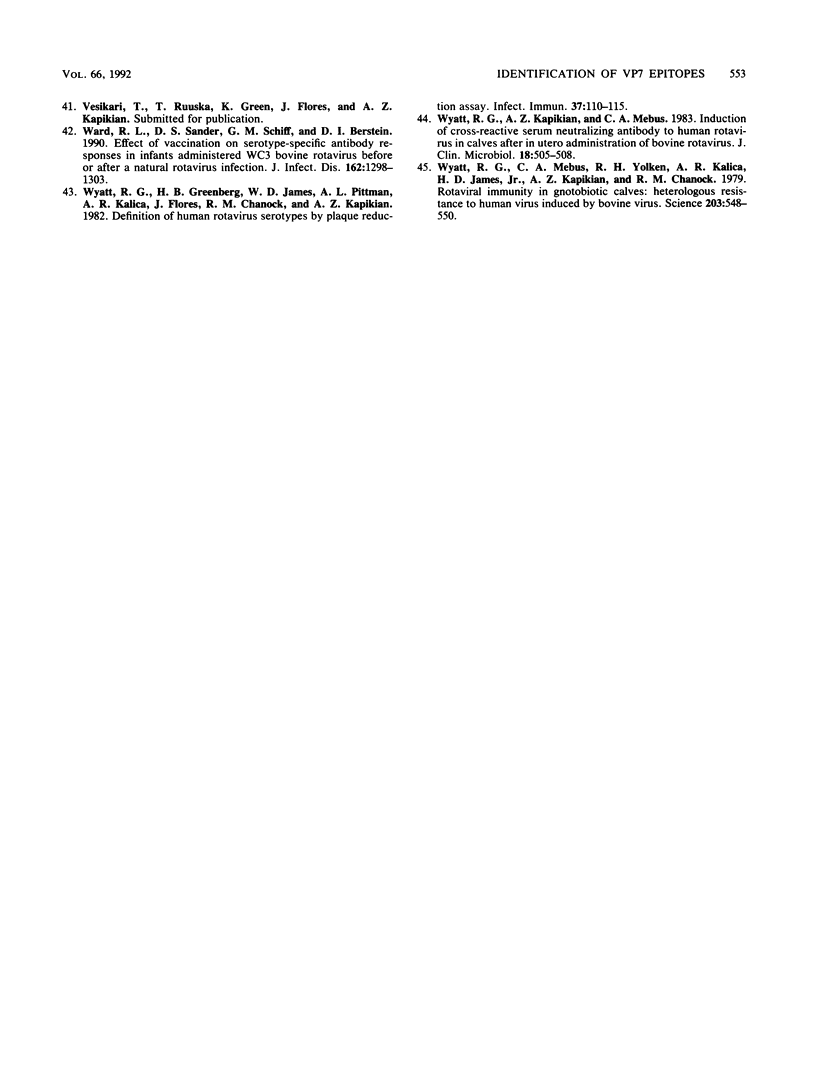
Selected References
These references are in PubMed. This may not be the complete list of references from this article.
- Bernstein D. I., Smith V. E., Sander D. S., Pax K. A., Schiff G. M., Ward R. L. Evaluation of WC3 rotavirus vaccine and correlates of protection in healthy infants. J Infect Dis. 1990 Nov;162(5):1055–1062. doi: 10.1093/infdis/162.5.1055. [DOI] [PubMed] [Google Scholar]
- Chiba S., Yokoyama T., Nakata S., Morita Y., Urasawa T., Taniguchi K., Urasawa S., Nakao T. Protective effect of naturally acquired homotypic and heterotypic rotavirus antibodies. Lancet. 1986 Aug 23;2(8504):417–421. doi: 10.1016/s0140-6736(86)92133-1. [DOI] [PubMed] [Google Scholar]
- Christy C., Madore H. P., Pichichero M. E., Gala C., Pincus P., Vosefski D., Hoshino Y., Kapikian A., Dolin R. Field trial of rhesus rotavirus vaccine in infants. Pediatr Infect Dis J. 1988 Sep;7(9):645–650. doi: 10.1097/00006454-198809000-00009. [DOI] [PubMed] [Google Scholar]
- Christy C., Madore H. P., Treaner J. J., Pray K., Kapikian A. Z., Chanock R. M., Dolin R. Safety and immunogenicity of live attenuated rhesus monkey rotavirus vaccine. J Infect Dis. 1986 Dec;154(6):1045–1047. doi: 10.1093/infdis/154.6.1045. [DOI] [PubMed] [Google Scholar]
- Clark H. F., Borian F. E., Bell L. M., Modesto K., Gouvea V., Plotkin S. A. Protective effect of WC3 vaccine against rotavirus diarrhea in infants during a predominantly serotype 1 rotavirus season. J Infect Dis. 1988 Sep;158(3):570–587. doi: 10.1093/infdis/158.3.570. [DOI] [PMC free article] [PubMed] [Google Scholar]
- Coulson B. S., Tursi J. M., McAdam W. J., Bishop R. F. Derivation of neutralizing monoclonal antibodies to human rotaviruses and evidence that an immunodominant neutralization site is shared between serotypes 1 and 3. Virology. 1986 Oct 30;154(2):302–312. doi: 10.1016/0042-6822(86)90456-3. [DOI] [PubMed] [Google Scholar]
- De Mol P., Zissis G., Butzler J. P., Mutwewingabo A., André F. E. Failure of live, attenuated oral rotavirus vaccine. Lancet. 1986 Jul 12;2(8498):108–108. doi: 10.1016/s0140-6736(86)91643-0. [DOI] [PubMed] [Google Scholar]
- Dyall-Smith M. L., Lazdins I., Tregear G. W., Holmes I. H. Location of the major antigenic sites involved in rotavirus serotype-specific neutralization. Proc Natl Acad Sci U S A. 1986 May;83(10):3465–3468. doi: 10.1073/pnas.83.10.3465. [DOI] [PMC free article] [PubMed] [Google Scholar]
- Flores J., Perez-Schael I., Gonzalez M., Garcia D., Perez M., Daoud N., Cunto W., Chanock R. M., Kapikian A. Z. Protection against severe rotavirus diarrhoea by rhesus rotavirus vaccine in Venezuelan infants. Lancet. 1987 Apr 18;1(8538):882–884. doi: 10.1016/s0140-6736(87)92858-3. [DOI] [PubMed] [Google Scholar]
- Gothefors L., Wadell G., Juto P., Taniguchi K., Kapikian A. Z., Glass R. I. Prolonged efficacy of rhesus rotavirus vaccine in Swedish children. J Infect Dis. 1989 Apr;159(4):753–757. doi: 10.1093/infdis/159.4.753. [DOI] [PubMed] [Google Scholar]
- Green K. Y., Sears J. F., Taniguchi K., Midthun K., Hoshino Y., Gorziglia M., Nishikawa K., Urasawa S., Kapikian A. Z., Chanock R. M. Prediction of human rotavirus serotype by nucleotide sequence analysis of the VP7 protein gene. J Virol. 1988 May;62(5):1819–1823. doi: 10.1128/jvi.62.5.1819-1823.1988. [DOI] [PMC free article] [PubMed] [Google Scholar]
- Green K. Y., Taniguchi K., Mackow E. R., Kapikian A. Z. Homotypic and heterotypic epitope-specific antibody responses in adult and infant rotavirus vaccinees: implications for vaccine development. J Infect Dis. 1990 Apr;161(4):667–679. doi: 10.1093/infdis/161.4.667. [DOI] [PubMed] [Google Scholar]
- Halsey N. A., Anderson E. L., Sears S. D., Steinhoff M., Wilson M., Belshe R. B., Midthun K., Kapikian A. Z., Chanock R. M., Samorodin R. Human-rhesus reassortant rotavirus vaccines: safety and immunogenicity in adults, infants, and children. J Infect Dis. 1988 Dec;158(6):1261–1267. doi: 10.1093/infdis/158.6.1261. [DOI] [PubMed] [Google Scholar]
- Hanlon P., Hanlon L., Marsh V., Byass P., Shenton F., Hassan-King M., Jobe O., Sillah H., Hayes R., M'Boge B. H. Trial of an attenuated bovine rotavirus vaccine (RIT 4237) in Gambian infants. Lancet. 1987 Jun 13;1(8546):1342–1345. doi: 10.1016/s0140-6736(87)90649-0. [DOI] [PubMed] [Google Scholar]
- Hoshino Y., Saif L. J., Sereno M. M., Chanock R. M., Kapikian A. Z. Infection immunity of piglets to either VP3 or VP7 outer capsid protein confers resistance to challenge with a virulent rotavirus bearing the corresponding antigen. J Virol. 1988 Mar;62(3):744–748. doi: 10.1128/jvi.62.3.744-748.1988. [DOI] [PMC free article] [PubMed] [Google Scholar]
- Kapikian A. Z., Cline W. L., Greenberg H. B., Wyatt R. G., Kalica A. R., Banks C. E., James H. D., Jr, Flores J., Chanock R. M. Antigenic characterization of human and animal rotaviruses by immune adherence hemagglutination assay (IAHA): evidence for distinctness of IAHA and neutralization antigens. Infect Immun. 1981 Aug;33(2):415–425. doi: 10.1128/iai.33.2.415-425.1981. [DOI] [PMC free article] [PubMed] [Google Scholar]
- Kapikian A. Z., Flores J., Hoshino Y., Glass R. I., Midthun K., Gorziglia M., Chanock R. M. Rotavirus: the major etiologic agent of severe infantile diarrhea may be controllable by a "Jennerian" approach to vaccination. J Infect Dis. 1986 May;153(5):815–822. doi: 10.1093/infdis/153.5.815. [DOI] [PubMed] [Google Scholar]
- Kapikian A. Z., Flores J., Midthun K., Hoshino Y., Green K. Y., Gorziglia M., Nishikawa K., Chanock R. M., Potash L., Perez-Schael I. Strategies for the development of a rotavirus vaccine against infantile diarrhea with an update on clinical trials of rotavirus vaccines. Adv Exp Med Biol. 1989;257:67–89. doi: 10.1007/978-1-4684-5712-4_9. [DOI] [PubMed] [Google Scholar]
- Kapikian A. Z., Wyatt R. G., Levine M. M., Black R. E., Greenberg H. B., Flores J., Kalica A. R., Hoshino Y., Chanock R. M. Studies in volunteers with human rotaviruses. Dev Biol Stand. 1983;53:209–218. [PubMed] [Google Scholar]
- Kapikian A. Z., Wyatt R. G., Levine M. M., Yolken R. H., VanKirk D. H., Dolin R., Greenberg H. B., Chanock R. M. Oral administration of human rotavirus to volunteers: induction of illness and correlates of resistance. J Infect Dis. 1983 Jan;147(1):95–106. doi: 10.1093/infdis/147.1.95. [DOI] [PubMed] [Google Scholar]
- Lanata C. F., Black R. E., del Aguila R., Gil A., Verastegui H., Gerna G., Flores J., Kapikian A. Z., Andre F. E. Protection of Peruvian children against rotavirus diarrhea of specific serotypes by one, two, or three doses of the RIT 4237 attenuated bovine rotavirus vaccine. J Infect Dis. 1989 Mar;159(3):452–459. doi: 10.1093/infdis/159.3.452. [DOI] [PubMed] [Google Scholar]
- Larralde G., Li B. G., Kapikian A. Z., Gorziglia M. Serotype-specific epitope(s) present on the VP8 subunit of rotavirus VP4 protein. J Virol. 1991 Jun;65(6):3213–3218. doi: 10.1128/jvi.65.6.3213-3218.1991. [DOI] [PMC free article] [PubMed] [Google Scholar]
- Mackow E. R., Shaw R. D., Matsui S. M., Vo P. T., Benfield D. A., Greenberg H. B. Characterization of homotypic and heterotypic VP7 neutralization sites of rhesus rotavirus. Virology. 1988 Aug;165(2):511–517. doi: 10.1016/0042-6822(88)90595-8. [DOI] [PubMed] [Google Scholar]
- Offit P. A., Clark H. F., Blavat G., Greenberg H. B. Reassortant rotaviruses containing structural proteins vp3 and vp7 from different parents induce antibodies protective against each parental serotype. J Virol. 1986 Nov;60(2):491–496. doi: 10.1128/jvi.60.2.491-496.1986. [DOI] [PMC free article] [PubMed] [Google Scholar]
- Perez-Schael I., Garcia D., Gonzalez M., Gonzalez R., Daoud N., Perez M., Cunto W., Kapikian A. Z., Flores J. Prospective study of diarrheal diseases in Venezuelan children to evaluate the efficacy of rhesus rotavirus vaccine. J Med Virol. 1990 Mar;30(3):219–229. doi: 10.1002/jmv.1890300315. [DOI] [PubMed] [Google Scholar]
- Rennels M. B., Losonsky G. A., Levine M. M., Kapikian A. Z. Preliminary evaluation of the efficacy of rhesus rotavirus vaccine strain MMU 18006 in young children. Pediatr Infect Dis. 1986 Sep-Oct;5(5):587–588. doi: 10.1097/00006454-198609000-00019. [DOI] [PubMed] [Google Scholar]
- Rennels M. B., Losonsky G. A., Young A. E., Shindledecker C. L., Kapikian A. Z., Levine M. M. An efficacy trial of the rhesus rotavirus vaccine in Maryland. The Clinical Study Group. Am J Dis Child. 1990 May;144(5):601–604. doi: 10.1001/archpedi.1990.02150290095037. [DOI] [PubMed] [Google Scholar]
- Ruuska T., Vesikari T., Delem A., André F. E., Beards G. M., Flewett T. H. Evaluation of RIT 4237 bovine rotavirus vaccine in newborn infants: correlation of vaccine efficacy to season of birth in relation to rotavirus epidemic period. Scand J Infect Dis. 1990;22(3):269–278. doi: 10.3109/00365549009027047. [DOI] [PubMed] [Google Scholar]
- Santosham M., Letson G. W., Wolff M., Reid R., Gahagan S., Adams R., Callahan C., Sack R. B., Kapikian A. Z. A field study of the safety and efficacy of two candidate rotavirus vaccines in a Native American population. J Infect Dis. 1991 Mar;163(3):483–487. doi: 10.1093/infdis/163.3.483. [DOI] [PubMed] [Google Scholar]
- Senturia Y. D., Peckham C. S., Cordery M., Chrystie I. A., Banatvala J. E., André F. E. Live attenuated oral rotavirus vaccine. Lancet. 1987 Nov 7;2(8567):1091–1092. doi: 10.1016/s0140-6736(87)91522-4. [DOI] [PubMed] [Google Scholar]
- Shaw R. D., Fong K. J., Losonsky G. A., Levine M. M., Maldonado Y., Yolken R., Flores J., Kapikian A. Z., Vo P. T., Greenberg H. B. Epitope-specific immune responses to rotavirus vaccination. Gastroenterology. 1987 Nov;93(5):941–950. doi: 10.1016/0016-5085(87)90555-5. [DOI] [PubMed] [Google Scholar]
- Snodgrass D. R., Wells P. W. Passive immunity in rotaviral infections. J Am Vet Med Assoc. 1978 Sep 1;173(5 Pt 2):565–568. [PubMed] [Google Scholar]
- Taniguchi K., Hoshino Y., Nishikawa K., Green K. Y., Maloy W. L., Morita Y., Urasawa S., Kapikian A. Z., Chanock R. M., Gorziglia M. Cross-reactive and serotype-specific neutralization epitopes on VP7 of human rotavirus: nucleotide sequence analysis of antigenic mutants selected with monoclonal antibodies. J Virol. 1988 Jun;62(6):1870–1874. doi: 10.1128/jvi.62.6.1870-1874.1988. [DOI] [PMC free article] [PubMed] [Google Scholar]
- Taniguchi K., Maloy W. L., Nishikawa K., Green K. Y., Hoshino Y., Urasawa S., Kapikian A. Z., Chanock R. M., Gorziglia M. Identification of cross-reactive and serotype 2-specific neutralization epitopes on VP3 of human rotavirus. J Virol. 1988 Jul;62(7):2421–2426. doi: 10.1128/jvi.62.7.2421-2426.1988. [DOI] [PMC free article] [PubMed] [Google Scholar]
- Vesikari T., Isolauri E., D'Hondt E., Delem A., André F. E., Zissis G. Protection of infants against rotavirus diarrhoea by RIT 4237 attenuated bovine rotavirus strain vaccine. Lancet. 1984 May 5;1(8384):977–981. doi: 10.1016/s0140-6736(84)92323-7. [DOI] [PubMed] [Google Scholar]
- Vesikari T., Isolauri E., Delem A., d'Hondt E., André F. E., Beards G. M., Flewett T. H. Clinical efficacy of the RIT 4237 live attenuated bovine rotavirus vaccine in infants vaccinated before a rotavirus epidemic. J Pediatr. 1985 Aug;107(2):189–194. doi: 10.1016/s0022-3476(85)80123-2. [DOI] [PubMed] [Google Scholar]
- Vesikari T., Rautanen T., Varis T., Beards G. M., Kapikian A. Z. Rhesus Rotavirus candidate vaccine. Clinical trial in children vaccinated between 2 and 5 months of age. Am J Dis Child. 1990 Mar;144(3):285–289. [PubMed] [Google Scholar]
- Ward R. L., Sander D. S., Schiff G. M., Bernstein D. I. Effect of vaccination on serotype-specific antibody responses in infants administered WC3 bovine rotavirus before or after a natural rotavirus infection. J Infect Dis. 1990 Dec;162(6):1298–1303. doi: 10.1093/infdis/162.6.1298. [DOI] [PubMed] [Google Scholar]
- Wyatt R. G., Greenberg H. B., James W. D., Pittman A. L., Kalica A. R., Flores J., Chanock R. M., Kapikian A. Z. Definition of human rotavirus serotypes by plaque reduction assay. Infect Immun. 1982 Jul;37(1):110–115. doi: 10.1128/iai.37.1.110-115.1982. [DOI] [PMC free article] [PubMed] [Google Scholar]
- Wyatt R. G., Kapikian A. Z., Mebus C. A. Induction of cross-reactive serum neutralizing antibody to human rotavirus in calves after in utero administration of bovine rotavirus. J Clin Microbiol. 1983 Sep;18(3):505–508. doi: 10.1128/jcm.18.3.505-508.1983. [DOI] [PMC free article] [PubMed] [Google Scholar]
- Wyatt R. G., Mebus C. A., Yolken R. H., Kalica A. R., James H. D., Jr, Kapikian A. Z., Chanock R. M. Rotaviral immunity in gnotobiotic calves: heterologous resistance to human virus induced by bovine virus. Science. 1979 Feb 9;203(4380):548–550. doi: 10.1126/science.216077. [DOI] [PubMed] [Google Scholar]


